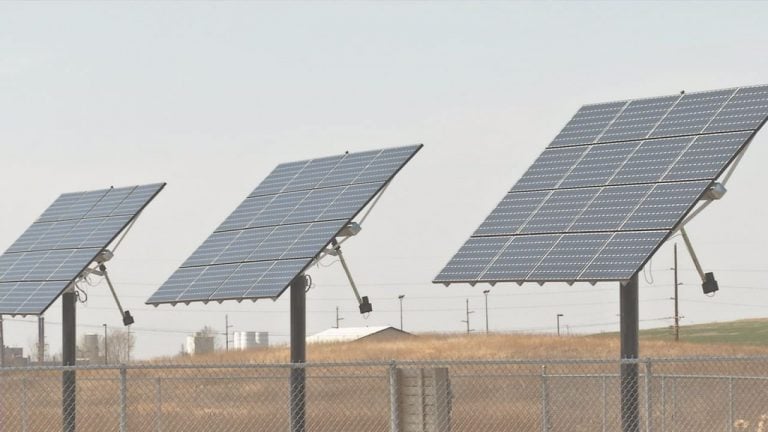Minnesotans push ahead with solar amid Trump opposition

ST. PAUL, Minn. (Minnesota Reformer) — More than 180 local households will see significantly lower energy bills after the solar array atop Abbott Northwestern Hospital’s new parking ramp powers up later this year.
Abbott Northwestern — Twin Cities’ largest private hospital — will enjoy similar savings while hosting Minneapolis nonprofit Cooperative Energy Futures’ newest community solar garden for at least the next 25 years.
It’s CEF’s second ramp-top solar garden — after the 3,760-panel installation at Ramp A in downtown Minneapolis — and one of its largest yet. Community solar garden subscribers typically save 20% to 30% on their monthly electricity bills, CEF says. Fifty-five percent of subscribers in the Abbott Northwestern garden qualify as low- or moderate-income. Canopy-style arrays like this one provide shade for people and cars in summer and reduce snow removal crews’ workloads come winter.
Perks like these helped CEF find long-term hosts for and draw nearly 1,000 subscribers to its 10 existing community solar gardens, a mix of rooftop and canopy arrays in the Twin Cities and ground-mounted installations farther out. CEF plans to energize at least three more gardens this year and has five projects in earlier stages of development, according to its 2025 annual report.
The future of projects like these are in doubt since the election of President Donald Trump, which has ushered in a federal government bent on making it harder for Americans to access affordable, non-polluting electricity.
Trump signed a partisan budget law on July 4 that sunsets federal solar tax credits years ahead of schedule while boosting already-generous fossil fuel subsidies, sending solar developers scrambling to grandfather as many projects as possible under the current rules. Days later, Trump made good on an apparent side deal with congressional conservatives and ordered the U.S. Treasury Department to take a hard line on those rules, possibly by increasing the amount of early investment projects need before they can qualify. Developers expect final guidance sometime next month, soon after Trump’s latest tariffs take effect (or not).
“Our lawyers are really trying to define our deadlines and we’re going to push as much as we can before we have to reorient,” CEF’s Dan Grantier told The Reformer at the Abbot Northwestern ribbon-cutting event.
A still taken from a handout video shows the the community solar garden on the Abbott Northwestern parking ramp. (Courtesy of Cooperative Energy Futures)
The Abbott Northwestern project illustrates the potential for creative uses of a solar garden in an urban environment. Hospital owner Allina Health approached CEF in 2019 as part of a campaign to endear its Midtown Minneapolis neighbors to the new parking ramp it needed for a major campus expansion, Allina Vice President of Facilities Tony LaCroix-Dalluhn recently told The Reformer.
“A parking structure is not exactly a welcome addition to the neighborhood, so we came up with a community solar garden to make it more appealing,” along with less conspicuous nods to sustainability, like a “maxed out” 200-stall bike parking area with showers and a pollinator garden along the Midtown Greenway, LaCroix-Dalluhn said.
“There’s not much benefit for us, but it’s great for the community,” he said.
Minnesota helped kickstart the American community solar movement thanks in large part to legislation championed by the late State Rep. Melissa Hortman and the doggedness of homegrown developers like CEF, which began weatherizing older Minneapolis homes in the late aughts. With more installed community solar capacity than all but three other states — more than 900 times the maximum output of the Abbott Northwestern system — Minnesota continues to punch well above its weight.
Despite Trump’s war on decarbonization, states and municipalities that care about climate change and energy access will continue to support solar development. Minnesota needs to add a lot more solar panels — as well as wind turbines and other carbon-free sources and batteries to provide grid stability — to meet its mandate for 100% carbon-free electricity by 2040, giving developers like CEF and dozens of smaller rooftop solar installation businesses clarity on long-term demand. House Democrats gave the industry another boost in the June special legislative session when they killed a budget provision that would have ended Minnesota’s community solar program in three years.
And despite tightening municipal budgets, some Minnesota cities offer generous incentives for residential and commercial solar projects. Businesses qualify for up to $50,000 and residential buyers’ groups up to $175,000 from the Minneapolis Green Cost Share program, for example.
“If you’re looking to build a parking ramp in Minneapolis, we want to talk to you,” Grantier said.
Even without federal subsidies, solar and backup batteries increasingly make financial sense for utility customers, said Michael Allen, cofounder and CEO of All Energy Solar.
But the slow, cumbersome process of getting new systems approved and connected to the grid — typically a 40-to-60-day wait for Xcel Energy customers “if everything goes smoothly,” he said — scares some prospects off and raises costs for the rest. Larger arrays can take many months or years to get utility approval, though Grantier said urban neighborhoods like Midtown tend to have more slack in the grid.
“Where legislators and regulators can really make a difference is by holding (utilities’) feet to the fire and taking a stand to improve things for Minnesotans,” Allen said.
Otherwise, he warned, more utility customers may take matters into their own hands and look for ways to reduce their reliance on the grid.
“The more we fight each other, the greater the desire there is to do something different,” he said.
(Story written by Brian Martucci – Minnesota Reformer)






